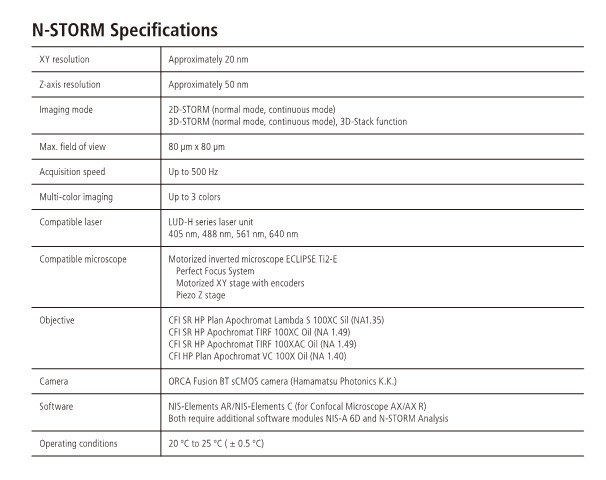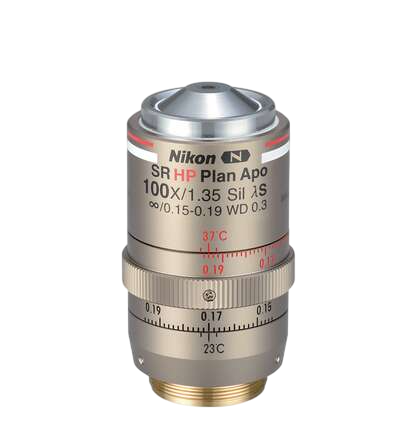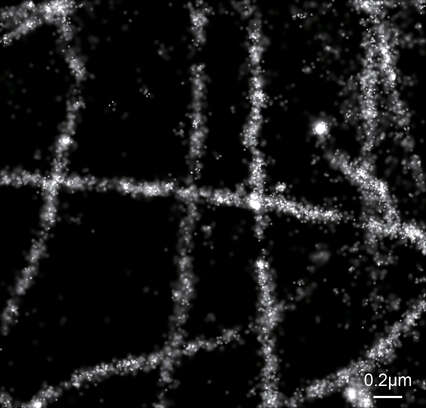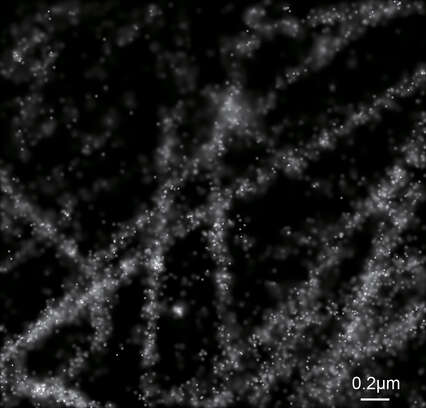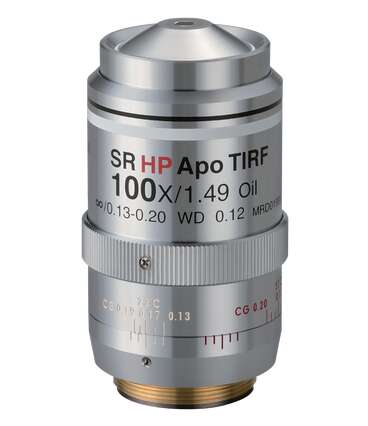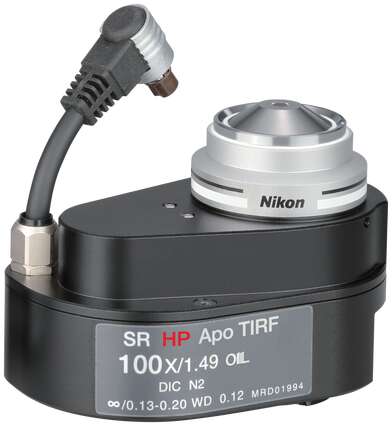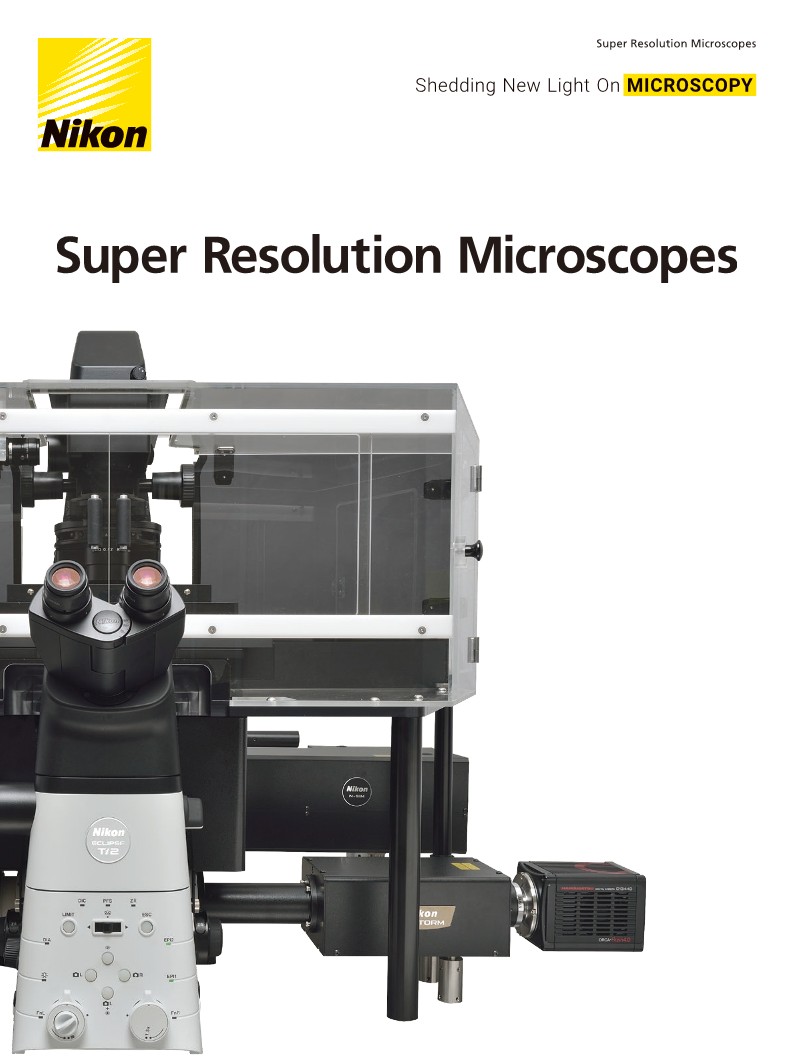x, y, z축 해상도 10배 증가
STORM(STochastic Optical Reconstruction Microscopy)은 복잡한 형광 현미경 샘플 내 개별 형광체의 정확한 위치 정보를 결합하여 초고해상도 형광 이미지를 재구성하는 기술입니다.
N-STORM은 니콘(Nikon)의 강력한 Ti2-E 도립 현미경을 활용하여 고정확도의 다중 색상 위치 분석 및 3차원(xyz) 재구성을 적용합니다.
이를 통해 기존 광학 현미경보다 10배 향상된 해상도 (xy축에서 약 20nm까지)로 초고해상도 이미징이 가능합니다.
이 강력한 기술은 나노 규모에서 분자 상호작용을 시각화할 수 있게 하여, 과학적 이해의 새로운 지평을 엽니다.

최대 50nm의 축 방향 해상도 10배 향상
최대 50nm의 축 방향 해상도 10배 향상
N-STORM은 측면(lateral) 초고해상도뿐만 아니라, 독자적인 방법을 활용하여 기존 광학 현미경 대비 축 방향(axial) 해상도를 10배 향상시키고 3D 나노스케일 정보를 제공합니다.
3D-Stack 기능은 다양한 Z 위치에서 여러 3D STORM 이미지를 캡처하고 하나의 이미지로 연결하여 더 두꺼운 STORM 이미지를 생성할 수 있도록 합니다.

최대 20nm의 측면 해상도 10배 향상
최대 20nm의 측면 해상도 10배 향상
N-STORM은 시야(field of view) 내에 존재하는 수천 개의 개별 형광체에 대한 고정확도 위치 정보를 활용하여, 기존 광학 현미경보다 공간 해상도가 10배 더 뛰어난(최대 20nm) 놀라운 "초고해상도" 이미지를 생성합니다.
-

*Alexa Fluor® 647(NUP153)과 ATTO 488(TPR)로 표지된 사람 자궁경부암 세포(HeLa S3) 이미지입니다
Photos courtesy of: Dr. Michael W. Davidson, National High Magnetic Field Laboratory, Florida State Universi -
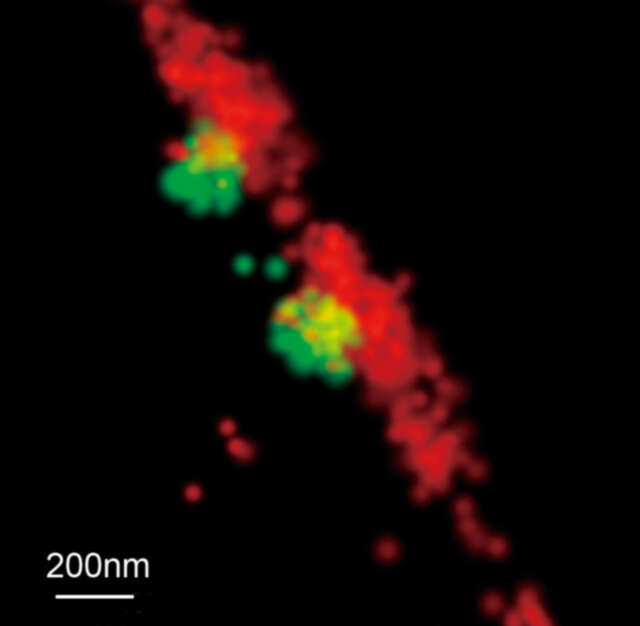
다이나믹 초고해상도 이미징(Dynamic Super-resolution Imaging)
새롭게 개발된 광학 및 조명 시스템은 sCMOS 기술에 최적화되어 이미지 획득 속도를 최대 10배까지 향상시켰습니다.
이에 따라 획득 시간이 '수 분'에서 '수 초'로 단축되면서, 살아있는 샘플에서 발생하는 동적인 현상(dynamic events)들을 이제 분자 수준의 해상도로 포착할 수 있게 되었습니다.
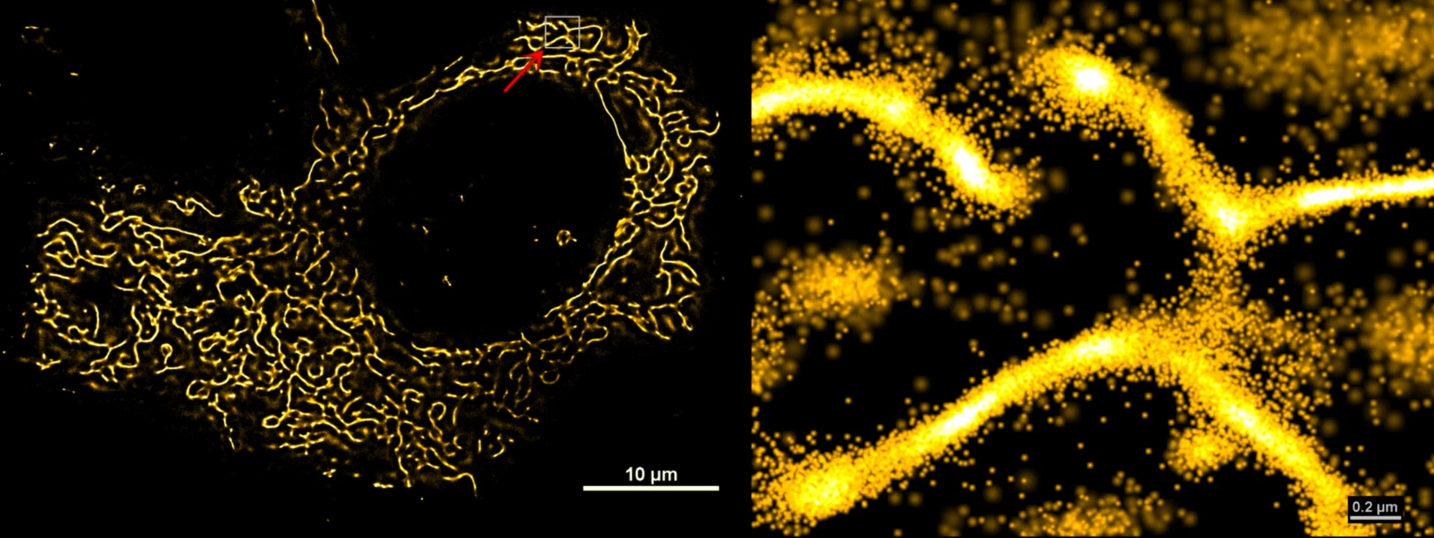
다중 색상 이미징 기능 (Multi-color Imaging Capability)
다중 색상 이미징 기능 (Multi-color Imaging Capability)
다중 색상 초고해상도 이미징은 순차적 활성화 이미징(sequential activation imaging)을 위한 활성자-리포터 쌍(activator-reporter pairs)과 연속 활성화 이미징(continuous activation imaging)을 위한 활성자-비활성자(activator-free) 표지자를 모두 사용하여 수행할 수 있습니다.
이러한 유연성 덕분에 사용자는 분자 수준에서 다중 단백질의 위치(localization) 및 상호작용 특성(interaction properties)에 대한 중요한 통찰력을 쉽게 얻을 수 있습니다.
고해상도, 고밀도 이미지 (High Definition, High Density Images)
새롭게 개발된 여기(excitation) 광학 장치와 향상된 이미지 획득 속도는 분자 위치 파악 밀도(molecule localization density)를 증가시켜, 거대 분자 구조(macromolecular structures)의 더 선명한 이미지를 얻을 수 있도록 합니다.
-

왼쪽: 개선된 이미지 품질
오른쪽: 개선 전 이미지 품질
스케일 바: 5µm
동일한 이미징 시간(20초) 내에 초고해상도 이미지 품질이 크게 향상된 것을 보여줍니다.
샘플: Alexa Fluor® 647로 표지된 BSC-1 세포의 튜불린(Tubulin)
획득 시간: 20초 -
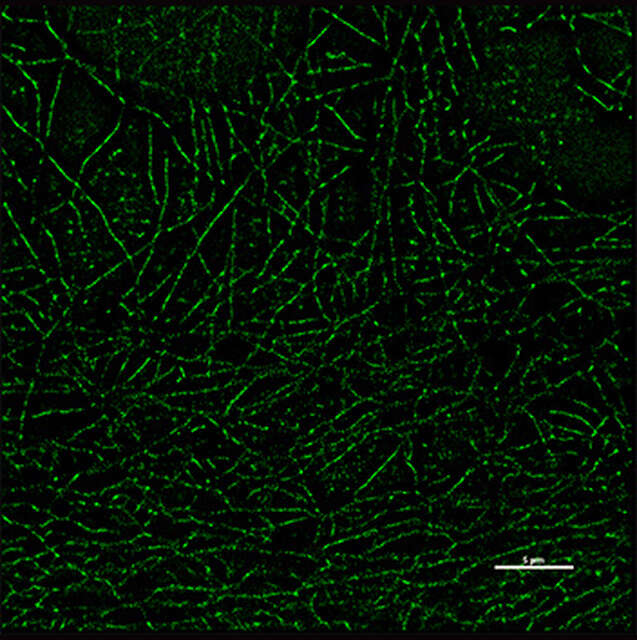
넓은 이미지 획득 영역 (Large Image Acquisition Area)
이미징 시스템에 새롭게 개발된 중간 줌 렌즈는 넓은 시야(field of view)에 최적화되었습니다.
이 광시야 모드(wide-view mode)는 80 µm x 80 µm의 이미징 영역을 달성하여, 이전 모델에 비해 이미징 영역이 4배 증가했습니다.

다중 스케일 실험을 위한 이미징 양식 간의 원활한 전환
N-STORM 시스템은 AX/AX R과 같은 공초점 현미경과 동시에 결합할 수 있습니다.
이를 통해 사용자는 낮은 배율의 넓은 시야(FOV)를 가진 공초점 이미지에서 원하는 샘플 위치를 지정한 다음, 이미징 방식을 간단히 전환하여 초고해상도 이미지를 획득할 수 있습니다.
공초점 현미경과 초고해상도 시스템을 결합하면, 초고해상도 정보에 대한 더 넓은 문맥적 시야를 얻을 수 있는 방법을 제공합니다.
즉, 샘플의 전체적인 구조를 공초점 현미경으로 확인한 후, 특정 관심 영역은 초고해상도로 상세하게 분석할 수 있어, 보다 포괄적인 이해가 가능해집니다.
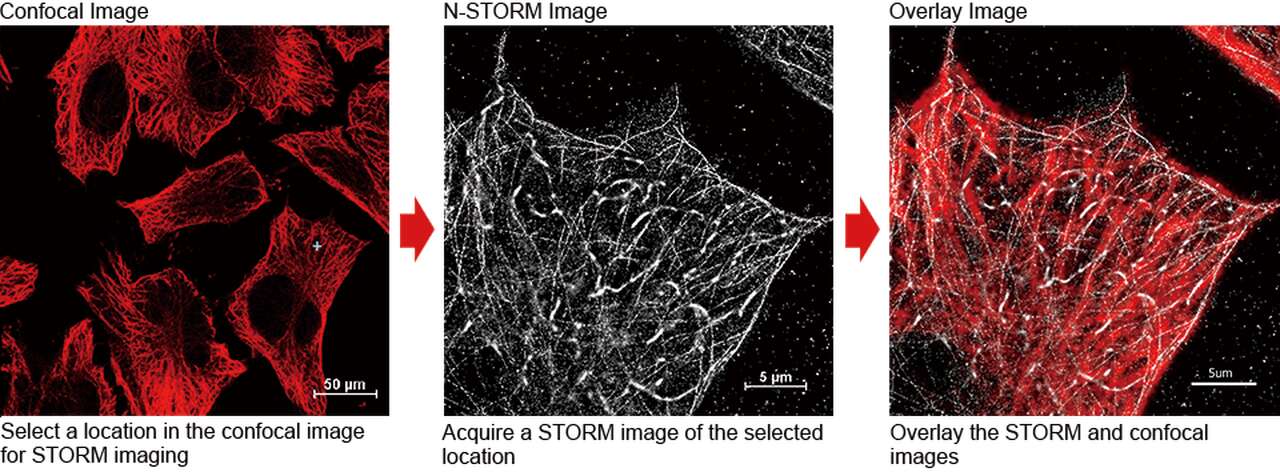
맞춤형 하드웨어 구성
니콘(Nikon) 시스템의 모듈식 디자인 덕분에, 완전 자동화된 TIRF(Total Internal Reflection Fluorescence) 조명 장치 또는 간단한 전동 TIRF 조명 장치, 최신 sCMOS 기술 또는 검증된 EMCCD 카메라 중에서 선택하여, 단일 분자 이미징(single molecule imaging) 및 그 이상의 요구사항에 맞춰 유연하고 안정적인 플랫폼을 맞춤 구성할 수 있습니다.
N-STORM 전용 대물렌즈
실리콘 침수 대물렌즈( Silicone immersion objectives )
실리콘 침수 대물렌즈(Silicone immersion objectives)는 살아있는 세포의 굴절률과 매우 유사한 높은 점성의 실리콘 오일을 침수액으로 사용합니다.
이러한 향상된 굴절률 호환성 덕분에, 이 대물렌즈들은 샘플 내부 더 깊은 곳에서 초고해상도 이미징을 수행할 때 광자 수집 능력과 해상도를 향상시킬 수 있습니다.
또한, 넓은 파장 범위에 걸쳐 우수한 색수차 보정 능력과 높은 투과율을 자랑합니다.
오일 침수 대물렌즈(Oil Immersion Objectives)
이 대물렌즈들은 N-STORM 이미징에 필요한 높은 개구수(Numerical Apertures)를 제공합니다. 특히 HP 대물렌즈는 형광체의 빠른 광전환(photoswitching)을 유도하는 데 필요한 초고출력 레이저와 호환됩니다.
이 렌즈들은 향상된 축 방향 색수차 보정(axial chromatic aberration correction) 기능을 제공하여, 3D 다중 색상 STORM 이미징에서 최고 수준의 위치 정확도(precision in localization)와 이미지 정렬(image alignment)을 달성할 수 있도록 합니다.
Ti2-E 현미경의 자동 보정 칼라(Auto Correction Collar)를 지원하는 AC-타입 대물렌즈는 보정 칼라를 정밀하고 쉽게 조정할 수 있도록 해줍니다.
스펙
